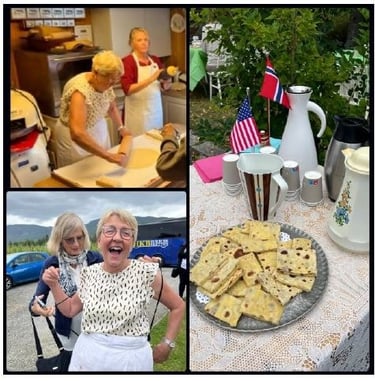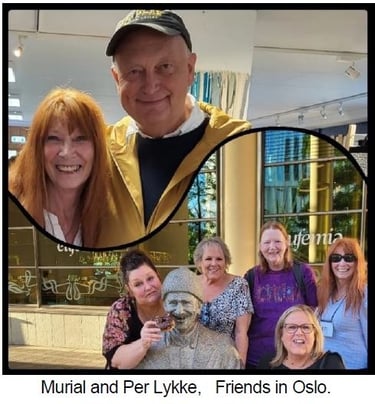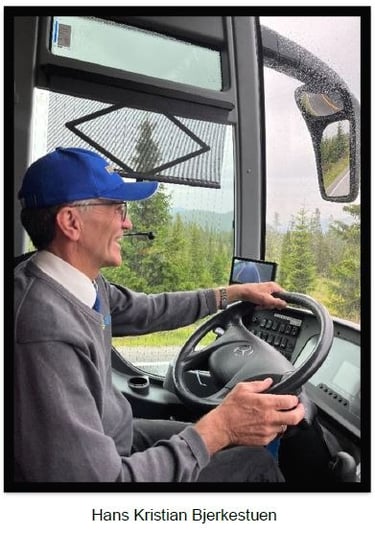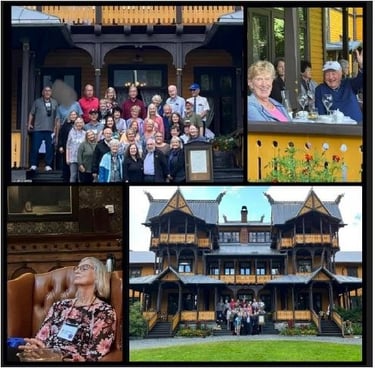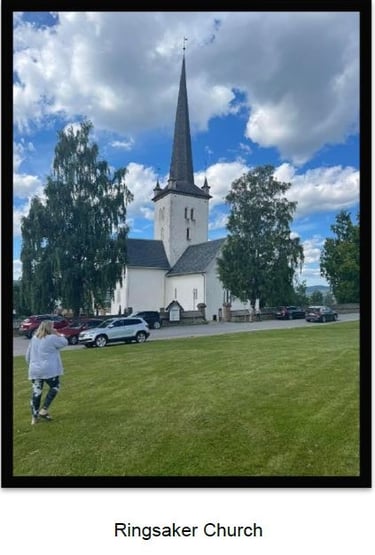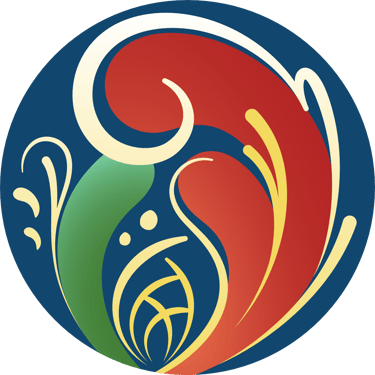2022 Vision of Norway Tour
Excerpted from Nov 2022 Telenews
TOURS
Elaine Nordlie, Sheryl Hove, Muriel Odden Coulter
11/19/20226 min read
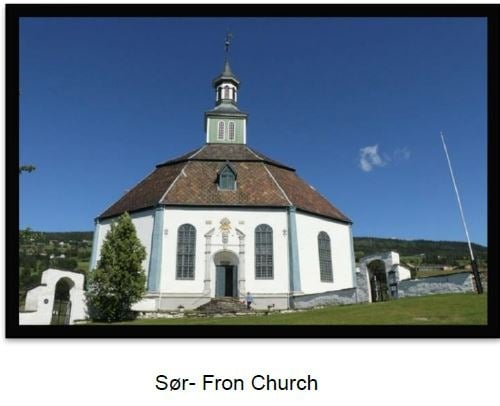

The Telelag Tour this past summer certainly presented a new view or vision of Norway. Since we started farther north than earlier Telelag tours and covered a large area of southern Norway, this tour brought many new experiences and sites. Most sites were planned carefully ahead of time, but, oh how much fun to suddenly be gifted with unplanned experiences.
Our bus driver, Hans Kristian Bjerkestuen from Tretten in Gudbrandsdalen, was not only an excellent driver but also took us to two “surprises.” Hans said “Since you Americans like churches, I think we should stop here.” We were treated to a pipe organ resounding in the eight- sided empty Sør-Fron Church. So perfectly timed, a substitute organist was practicing for the following Sunday’s service.
After our Lillehammer stay, Han’s second treat was the site of the large and most authentic Medieval stone Ringsaker Church. Our young female guide (a professional singer and composer) sang “You Raise Me Up” with such volume and emotional intensity that it brought several of us to tears.
A highlight for all was seeing the spacious Gjøvik Olympic Hockey Arena, constructed inside the mountain and used first during the 1994 Olympics.
Our guide was exceptional and answered many of our curious questions.
Of course, our main goal was Telemark where we were treated first to a surprise lunch at the Tinn Handwork Center and where the many ancestral farm visits would begin. There were eighteen farm visits during our time in Telemark.
After our Rjukan visit and Gaustblikk Mountain Hotel stay, Hans had to agree that Telemark was quite a unique and beautiful fylke. It is here most of the stories begin. The tour members have been inspired to write about a special experience on the tour. Read and enjoy!
A+ Hospitality and Learning Traditional Kling/Lefse Rolling
By Elaine Nordlie
Anne Underberg, sixth generation farm owner, lives on the idyllic Underberg farm in Gvarv, Telemark. She invited our 38-member Telelag tour group to her farm for a traditional meat, vegetable, and barley soup lunch and for lefse/kling baking demonstrations. What great “bait” when promoting a tour.
Anne owns and operates a rural baking kitchen on her farm– Heimebakeri (Home Bakery), located in the brewing house built in 1919. In a noted Norwegian magazine Lev Landlig, (Live Country) Anne is noted for her “dancing rolling pin.” She opens her heimebakeri to locals for the sale of her well-known kling (a finer dessert type of lefse) and lefse.
Our bus rolled into the narrow farm driveway lined with apple orchards. In the farmyard we were greeted by several smiling faces --- Anne, her friend Mona Sæland, and family and friends. After introductions, we were shown to the many colorful decorated tables she had set in her yard. She had also set two tables in an old small summer kitchen. A large bowl or pot with traditional thick soup was placed in the middle of each table. Anne’s homemade flatbread was served with the soup.
Since there was limited space in her heimebakeri, groups of six people at a time were invited to gather closely around the table where Anne and her assistant Mona took turns demonstrating the technique of rolling lefse carefully on a flannel cloth.
All details of making the dough, rolling, baking, and storing were written on her recipe and given to each person/family. Authors of the Sauherad kling recipe, Flatbread from Skafså, and specifics of rolling and griddling were written by Mona Sæland and Anne.
To our surprise, we found that they didn’t include boiled potatoes or potato flakes in their lefse recipe! As Norwegian-Americans, many are still using the old immigrant recipe with potatoes, that our great-grandmothers and grandmothers used. The lefse we received that day was very tasty without potatoes! She explained the difference between kling and lefse. The kling recipe includes egg, sour cream, and melk or cream with the flour. She serves her kling spread with butter and sugar with a cup of coffee. Lefse, with the potato ingredient, is served with lutefisk, rakefisk (half-fermented trout), or spekemat (dried meats). This explains why we have potatoes in our lefse recipe when served at our Christmas meals.
In August of 2017 when researching for her new lefse & kling book in English, Anne and Mona came to Minnesota searching for lefse recipes, types of flour, and taste tests. In Minnesota it is most common to make lefse at Christmas time, so it is often a challenge to find freshly baked lefse in the summer. They visited Elaine Nordlie for three days in hopes to find lefse at a county fair or Scandinavian store, but that was unsuccessful. Using Norwegian recipes with American food products, Anne has now completed her book and is searching for an American publisher to print her lefse book for the US market.
Anne’s gracious hospitality was beyond what we expected. Time always escapes us when we are enjoying ourselves. We needed to say “Goodbye” to Anne, Mona, and their friends and family. Welcome to Minnesota Anne and Mona!
Dalen Hotel
By : Elaine Nordlie
Our group was fortunate to enjoy afternoon tea at the Dalen Hotel. Known as the “hotel from the fairytales,” it originally opened in 1894 and is one of the oldest wooden hotels along the Telemark Canal. Because of the location, it became well-known throughout Europe and a popular hotel for royalty. After falling into disrepair during WWII, it was closed for many years, finally to be restored and reopened in 1992. In 2000, the hotel received the conservation organization Europa Nostra's highest award - a silver medal - for preserving the hotel as a unique cultural monument. The architecture, antiques, and beautiful grounds made it a perfect place for our group to relax. We were treated to lovely live piano music along with a lavish afternoon tea with pastries, scones and tasty sandwiches.
The Trip of a Lifetime
By: Muriel Odden Coulter
The Telelaget journey in Norway was amazing!! The trip of a lifetime! Every site, town, and city was exciting and interesting so it is extremely difficult to write about one or two memories.
One of many adventures was an event that I had not planned! Hiking with Per Lykke in the Hardanger Plateau to the Saboteur's cabin was an experience that I never imagined that I would ever be able to do. I had read so many stories about these brave men! To actually walk where these men walked was quite an experience!
Another highlight of my trip was developing new friendships! I loved getting to know everyone and hearing their stories. I enjoyed my roommate's company and enjoyed our hikes around the hotels and on the streets throughout the beautiful cities! Visiting her relative's home was very special. Also, sitting in the back of the bus with crazy friends was a hoot-- constant laughs after another! Meeting 'Nixon' at the porcelain factory was an unexpected pleasure!!
Of course, another very special part of this trip was visiting relatives and being on the farm where my grandfather was born, seeing the home where he played as a young boy, and visiting the school which he attended, and, later, where he taught. I hold many happy memories of this trip, and, hopefully, will be able to return to my grandfather's home again.
My Farm Visit to Hjartdal
By: Sheryl Hove
My ancestors emigrated from Hjartdal kommune in Telemark fylke in 1847. My great-great-grandmother, Øli Olsdatter, was born on the Hjartsjø-lia farm in 1829 to Ole Olson of the Hjartsjø- lia farm and Anne Olsdatter of the Lonar farm. Øli was almost 18 years old when her parents and 9 siblings made the journey to Columbia County, Wisconsin where they Americanized their names. Øli became Ellen and Olsdatter Hjartsjø-lia became Jarsko, then Jarshow, then Jarshaw. In Wisconsin Ellen married Neils Neilson of the Skogen farm in Rollag kommune in Buskerud fylke, and they moved to Faribault County, Minnesota where he changed his name to Nels Skogen. Her name on her gravestone is Ellen Skogen. On August 2 on our Tour, one of our TOA liaisons, and my new relative, Anne Haugen Wagn, and her husband, Svein Erik Wagn, drove me to the Lonar farm
where we met another new relative, Sigrun Lonar. Then we went to the Hjartsjø farm and then up the hill to the Hjartsjø-Lia farm where I met more new relatives, Tommy Lia Schei and his wife Merete Pladsen Schei. Tommy’s farm is maintained as a museum. We stopped at the Hjartdal Church and Cemetery where my previous ancestors were buried before 1847.
